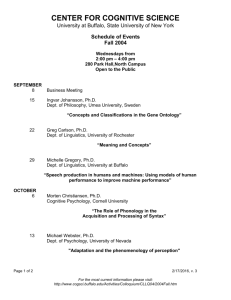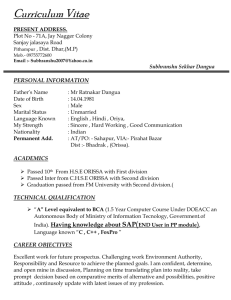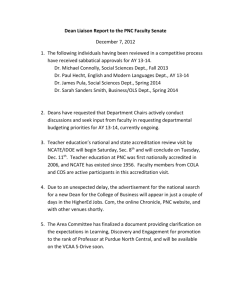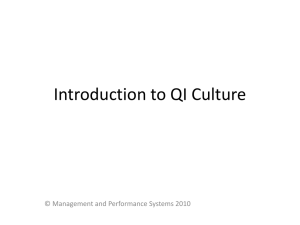NEUROSCIENCE DAY AT UNIVERSITY OF GUELPH
advertisement
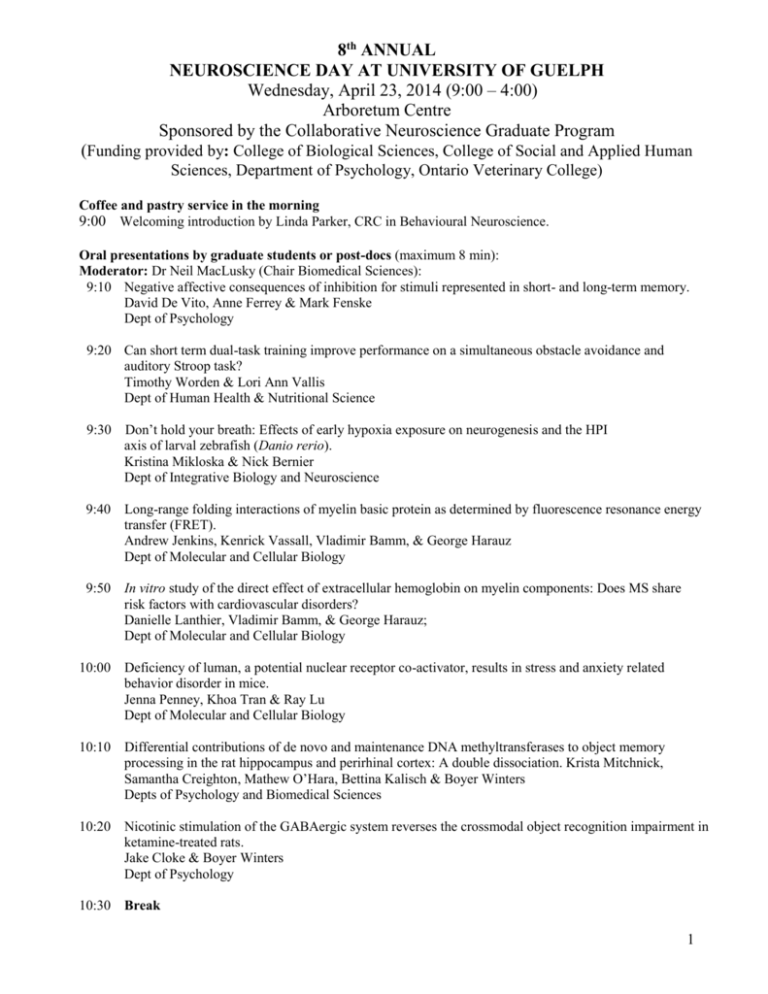
8th ANNUAL NEUROSCIENCE DAY AT UNIVERSITY OF GUELPH Wednesday, April 23, 2014 (9:00 – 4:00) Arboretum Centre Sponsored by the Collaborative Neuroscience Graduate Program (Funding provided by: College of Biological Sciences, College of Social and Applied Human Sciences, Department of Psychology, Ontario Veterinary College) Coffee and pastry service in the morning 9:00 Welcoming introduction by Linda Parker, CRC in Behavioural Neuroscience. Oral presentations by graduate students or post-docs (maximum 8 min): Moderator: Dr Neil MacLusky (Chair Biomedical Sciences): 9:10 Negative affective consequences of inhibition for stimuli represented in short- and long-term memory. David De Vito, Anne Ferrey & Mark Fenske Dept of Psychology 9:20 Can short term dual-task training improve performance on a simultaneous obstacle avoidance and auditory Stroop task? Timothy Worden & Lori Ann Vallis Dept of Human Health & Nutritional Science 9:30 Don’t hold your breath: Effects of early hypoxia exposure on neurogenesis and the HPI axis of larval zebrafish (Danio rerio). Kristina Mikloska & Nick Bernier Dept of Integrative Biology and Neuroscience 9:40 Long-range folding interactions of myelin basic protein as determined by fluorescence resonance energy transfer (FRET). Andrew Jenkins, Kenrick Vassall, Vladimir Bamm, & George Harauz Dept of Molecular and Cellular Biology 9:50 In vitro study of the direct effect of extracellular hemoglobin on myelin components: Does MS share risk factors with cardiovascular disorders? Danielle Lanthier, Vladimir Bamm, & George Harauz; Dept of Molecular and Cellular Biology 10:00 Deficiency of luman, a potential nuclear receptor co-activator, results in stress and anxiety related behavior disorder in mice. Jenna Penney, Khoa Tran & Ray Lu Dept of Molecular and Cellular Biology 10:10 Differential contributions of de novo and maintenance DNA methyltransferases to object memory processing in the rat hippocampus and perirhinal cortex: A double dissociation. Krista Mitchnick, Samantha Creighton, Mathew O’Hara, Bettina Kalisch & Boyer Winters Depts of Psychology and Biomedical Sciences 10:20 Nicotinic stimulation of the GABAergic system reverses the crossmodal object recognition impairment in ketamine-treated rats. Jake Cloke & Boyer Winters Dept of Psychology 10:30 Break 1 10:50 The effects of blocking hippocampal dopamine D1-type receptors on social learning of food preferences, feeding and social interactions in male and female mice. Richard Matta, Angela Tiessen, Michelle Kivlenieks, Angela Meersseman, Yaw Adjei-Afriyie & Elena Choleris Dept of Psychology 11:00 How is the response to a vestibular perturbation affected after depression of the cerebellum? Chris Lam, Gagan Gill, Rich Staines, Craig Tokuno & Leah Bent Dept of Human Health and Nutritional Science 11:10 A comparison of treatments for anticipatory nausea using a rat model. Erin Rock, Cheryl Limebeer, Roshan Navaratnam, Martin Sticht, Kristin Engeland, Rachel Downey, Heather Morris, Meagan Jackson & Linda Parker: Dept of Psychology 11:20 The role of visceral insular cortex endocannabinoids in nausea-induced conditioned gaping in rats. Martin Sticht, Cheryl Limebeer, Rehab Abdullah, Justin Poklis, Aron Lichtman & Linda Parker Dept of Psychology 11:30 The study of intraoral self-administration. Meenu Minhas, AnneMarie Levy & Francesco Leri Dept of Psychology 11:40 A potential method for assessing awareness of emotions in nonhuman animals. Walter Sánchez-Suárez, Liz Paul (University of Bristol), Melissa Bateson (University of Newcastle) & Georgia Mason Dept of Animal and Poultry Science 11:50 Developing a novel mouse model of fetal alcohol spectrum disorder. Emma Louth & Craig Bailey Dept of Biomedical Sciences 12:00 The effects of gonadectomy on hippocampal dendritic spine density and branching in adult male mice: Dallon McMahon, Atwi S, Craig Bailey, Neil MacLusky Dept of Biomedical Sciences 12: 15 - 2:30 Lunch (served) and Poster Presentations Posters (Landscape –width 4’ x height 3’- set up before 9 am) 1. Salvia vapor inhalation decreases synaptic transmission in the rat dentate gyrus in vivo: Brewer M, McKay B; Dept of Psychology, Wilfrid Laurier University 2. Early-in-life repetitive binge exposure to toluene leads to less severe toluene intoxication as an adult: McKay M, McKay B; Dept of Psychology, Wilfrid Laurier University 3. Chronic toluene exposure impairs place cell activation in the CA3 region of the rat hippocampus: Kelly T, Gheidi A, Browne C, Odintsova I, Dunn MB, Marrone D, McKay B; Dept of Psychology, Wilfrid Laurier University 4. Recovery form toluene intoxication is facilitated by the NMDA receptor co-agonist D-serine but not the GABA-A receptor antagonist picrotoxin: Samuel-Herter S, Chang P, McKay B; Dept of Psychology,Wilfrid Laurier University 2 5. Differentiating the contributions of friendship characteristics and mental health factors to the frequency of use and motives to use MDMA: Backhouse F, Breckenridge S, McKay B 6. Predicting future sucrose consumption: Valyear M, Senthinathan G, Celejewski A, Eikelboom R; Dept of Psychology, Wilfrid Laurier University 7. Intermittent access to sweets: A prepubertal investigation: Senthinathan G, Eikelboom R; Dept of Psychology, Wilfrid Laurier University 8. Male-induced estrous cycle synchrony: Does it occur in rats?: Leach K, Mastroianni A, Eikelboom R; Dept of Psychology, Wilfrid Laurier University 9. The Effects of Perinatal Δ9-THC Exposure on Later-Life Behavioural Response: Danielle Haynes & Paul Mallet; Dept of Psychology, Wilfrid Laurier University 10. Examination of 5-HT2C receptor agonists in models of nausea: Silenieks LB, Limebeer CL, Higgins GA, MacLusky N, Parker LA; Depts of Biomedical Sciences and Psychology 11. Monoacylglycerol lipase inhibition attenuates acute and anticipatory nausea in rats: Downey RI, Limebeer CL, Morris H & Parker LA; Dept of Psychology 12. The effect of FAAH, MAGL and dual FAAH/MAGL enzyme inhibition on the rat model of anticipatory nausea: Ward J, Limebeer CL, Parker LA; Dept of Psychology 13. Effect of enhancing the endocannabinoid system on acute nausea in rats: Turvey G, Limebeer CL, Parker LA; Dept of Psychology 14. Delivery of the CB1 antagonist, AM251, bilaterally to the central nucleus of the amygdala and its effects on morphine withdrawal: Wills KL, Kalmar AS, Vemuri K, Limebeer CL, Makriyannis A, Parker LA; Dept of Psychology 15. Involvement of the G-protein coupled estrogen receptor in the female mouse hippocampus in social and object recognition learning without spatial cues: Lymer J, Gabor C, Phan A, Young-MacDonald F, Morris H, Choleris E; Dept of Psychology 16. Do estrogens in the hippocampus rapidly affect social learning in mice?: Ervin K, Sinclair K, Moore A, Choleris E; Dept of Psychology 17. A study of intake of sucrose and HFCS in no-food restricted rat: El-Baba M, Levy AM, of Psychology Leri F; Dept 18. The effects of high vs. low fructose to glucose ratio sugars on rat behavior and neuronal activation in the nucleus accumbens: Downs T, Shore A, Kent K, Marshall P, Leri F; Dept of Psychology 19. The effects of high vs. low fructose to glucose ratio sugars on self-administration and c-Fos expression in the rat hypothalamus: Shore A, Kent K, Marshall P, Daniels S, Downs T, Leri F; Dept of Psychology 3 20. The role of mu and kappa opioid receptors in stress and prime-induced reinstatement of sugar seeking: Ferdinand J, Marshall P, Leri F; Dept of Psychology 21. High fructose corn syrup withdrawal in rats: Pursuing biological markers of depression: Daniels S, Leri F; Dept of Psychology 22. Do differences in fructose/glucose ratios matter? A study of self-administration effects on sugarseeking behavior: Marshall P, Kent K, Daniels S, Shore A, Downs T, Leri F; Dept of Psychology 23. Measuring the palatability of high fructose corn syrup and sucrose in naïve and experienced rats: Colangelo GM, Levy AM, Leri F; Dept of Psychology 24. Intraoral self-administration of sweeteners in laboratory rats: Levy AM, Colangelo G, El-Baba M, Limebeer CL, Parker LA, Leri F; Dept of Psychology 25. The effect of NMDA receptor antagonism on multisensory integration in mice: Palmer D, Binsell E, Winters BD; Dept of Psychology 26. Epigenetic mechanisms of spatial and object memory in the rat hippocampus and perirhinal cortex: Creighton S, Mitchnick K, Winters BD; Dept of Psychology 27. Assessing the contribution of the orbitofrontal cortex to cross-modal object recognition in rats: Moon M, Boughner E, Jacklin DL, Winters BD; Dept of Psychology 28. Differential involvement of the histone acetyltransferases (HATs) CBP, p300 and PCAF in the hippocampus and perirhinal cortex of rats for object memory processing: Humble JB, Mitchnick KA, Christen B, Van Tiggelen M, Zaika O, Creighton S, Cloke J, Kalisch BE, Winters BD; Dept of Psychology 29. Nicotinic signaling in the developing hippocampus: A study of pyramidal neurons: Chung B, Jacklin D, Bignell W, Winters BD, Bailey C; Dept of Biomedical Sciences 30. Effect of docosahexaenoic acid (DHA) and epigallocatechin gallate (EGCG) on alpha-secretase activity: Azizi H, Kalisch BE; Dept of Biomedical Sciences 31. The effect of anandamide on APP, BACE1 and ApoE mRNA expression: Brar N, Kalisch BE; Dept of Biomedical Sciences 32. The role of the cannabinoid system on nerve growth factor expression: GahnSmith K, Dept of Biomedical Sciences Kalisch BE; 33. Deficiency of luman, a potential nuclear receptor co-activator, results in stress and anxiety related behavior disorder in mice: Penney J, Tran K, Lu R; Dept of Molecular and Cellular Biology 34. Luman knockout mice show less anxiety and depression: Tran K, Lu R; Dept of Molecular and Cellular Biology 4 35. Activation of the ERK/MAPK pathway by dimethyl sulfoxide is prevented by the 5alpha-reduced testosterone metabolite 3alpha-androstanediol via GABAergic modulation in SH-SY5Y neuroblastoma cells: Mendell AL, Kalisch BE, MacLusky NJ; Dept of Biomedical Sciences 36. The modulatory effects of non-aromatizable androgens on GABA currents of pyramidal cells in the medial prefrontal cortex: Reid B, Bailey C, MacLusky NJ; Dept of Biomedical Sciences 37. Effects of the estrous cycle on dendritic spine morphology in CA1 and CA3 of female rat hippocampi: Atwi S, MacLusky NJ; Dept of Biomedical Sciences 38. Androgen-mediated regulation of brain-derived neurotrophic factor (BDNF) in the male mouse hippocampus: Atwi S, MacLusky NJ; Dept of Biomedical Sciences 39. Reaching the limits of cognitive resources: Control strategies used by children during a multi-task paradigm: Hinton DC, Vallis LA; Dept of Human Health and Nutritional Science 40. How does visual manipulation affect obstacle avoidance strategies used by athletes and non-athletes?: Bijman M, Fisher J, Vallis LA; Dept of Human Health and Nutritional Science 41. Effects of planning time and practice on the obstacle avoidance strategies of older adults: Fisher JJ, Gurney MD, Vallis LA; Dept of Human Health and Nutritional Science 42. The effect of therapeutic ultrasound on pressure point pain: Cameron L, Srbely J; Dept of Human Health and Nutritional Science 43. Investigation of cutaneous afferent vibration sensitivity from the human foot sole: Strzalkowski N, Bent LR; Dept of Human Health and Nutritional Science 44. The influence of cutaneous vibration applied to the foot sole and foot dorsum on ankle proprioception: Mildren R & Bent LR; Dept of Human Health and Nutritional Science 45. Is the dorsal foot skin used to control posture during a vestibular perturbation?: Yip MC, Brown SHM, Bent LR; Dept of Human Health and Nutritional Science Gill G, 46. Is vision used to calibrate the spatial orientation of vestibular input during perturbation recovery: Toth AJ, Zettel JL, Bent LR; Dept of Human Health and Nutritional Science 47. Tracking illusory contour figures: Dienes N, Trick LM; Dept of Psychology 48. Memory mediates the negative affective consequences of response inhibition for visual stimuli: De Vito D, Mitchnick KA, Frischen A, Fenske MJ; Dept of Psychology 49. Learning pains: Does rejection have to be ‘social’ to impact subsequent behavior?: Driscoll RL, Fenske MJ, Barclay P; Dept of Psychology 50. Contingent attentional capture by stimuli that match long-term memory representations: Giammarco M, Paoletti A, Al-Aidroos N; Dept of Psychology 5 51. The application of attentional goals across the stages of visual processing: Dube B, Al-Aidroos N; Dept of Psychology 52. The role of cholinergic muscarinic receptors in cross-modal object recognition: Varkovetski M, Winters BD; Dept of Psychology Coffee service in afternoon 2:30 – 4:00 Keynote address “Neural Stem Cells: From development to repair.” Dr. Freda Miller Professor of Molecular Genetics University of Toronto Canada Research Chair in Developmental Neurobiology Hospital for Sick Children Research Institute Neuroscience Day Program Committee: Linda Parker, Psychology, Chair Craig Bailey, Biomedical Sciences Fred Laberge, Integrative Biology John Vessey, Molecular and Cellular Biology 6

